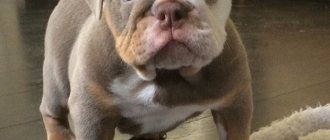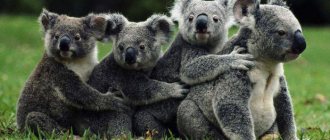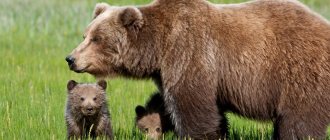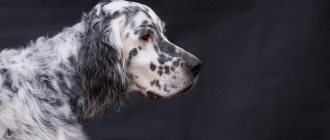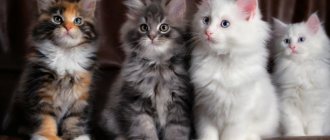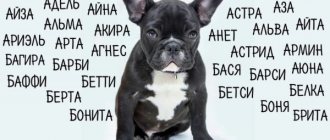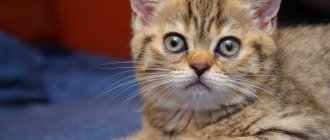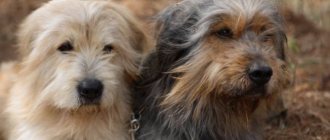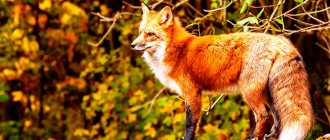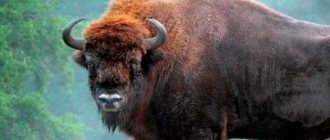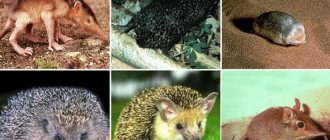The topic “Animals” is one of the first ones encountered when learning English. Today we will look at the names of domestic animals, wild animals, groups of animals (such as a flock) in English, and also learn how animals “speak” in English. All words are given with transcription and translation.
Pet names in English
| domestic animals | [dəʊˈmɛstɪk ˈænɪməlz] | Pets |
| cow | [kaʊ] | cow |
| bull | [bʊl] | bull |
| horse | [hɔːs] | horse |
| stallion | [ˈstæljən] | stallion |
| mare | [meə] | mare |
| goat | [gəʊt] | goat |
| he goat | [hiː] [gəʊt] | goat |
| sheep | [ʃiːp] | sheep |
| ram | [ræm] | ram |
| donkey | [ˈdɒŋki] | donkey |
| mule | [mjuːl] | mule |
| pig | [pɪg] | pig |
| cat | [kæt] | cat |
| dog | [dɒg] | dog |
| calf | [kɑːf] | calf |
| lamb | [læm] | lamb |
| foal | [fəʊl] | foal |
| piglet | [ˈpɪglət] | pig |
| kitten | [ˈkɪtn] | kitty |
| puppy | [ˈpʌpi] | puppy |
| mouse | [maʊs] | mouse |
| rat | [ræt] | rat |
| chinchilla | [ʧɪnˈʧɪlə] | chinchilla |
| hamster | [ˈhæmstə] | hamster |
| guinea pig (cavy) | [ˈgɪni pɪg] [ˈkeɪvi] | guinea pig |
Note:
- The plural of mouse is mice , not mices.
- The plural of the word sheep sheep (the forms are the same).
ABC of animals. Letter "N".
In the category of this letter there will be similar names of breeds, differing in second adjectives or nouns, but having a second name, as well as their own classification number.
Neapolitan Mastiff or Neapolitan Mastino, but according to the classification this breed is simply Mastino (RN ICF 197), belongs to the Molosser group.
The German Hound (PH ICF 299) has a second name - Sauerland Brack.
The German rough-haired pointer or Stichelhaar (PH ICF 232) has been known since the 16th century.
German Longhaired Pointer or Langhaar (PH FCI 117). Its ancestors were the so-called bird dogs, hawk dogs and water dogs. They started breeding in 1879.
German
wirehaired pointer or drathaar (RN FCI 98). At the end of the 14th century, this breed was created on the basis of the Stichelhaar, Poodlepointer, Griffon Korthals and shorthaired pointer.
German Shorthaired Pointer or Shorthaired Pointer (RN FCI 119). Its ancestors were dogs that lived in the countries of the Mediterranean region, where they were used to hunt game birds with nets.
The German Shepherd (PH ICF 166) is a service dog, but belongs to the group of herding dogs.
The German Boxer (RN FCI 144) belongs to the Molosser group.
The Great Dane (PH ICF 235) also belongs to the Molosser group.
The German Spitz belongs to the European Spitz and has five varieties, united by one classification number (PH ICF 97) - wolf Spitz (Keeshond), large Spitz, medium Spitz, small Spitz and dwarf Spitz (Pomeranian).
The Niverney Griffon (RN FCI 17) is a hound. Country of origin France.
The Nova Scotia Retriever (PH ICF 312) is a game fetch dog. Country of origin Canada.
The Norrbotten Spitz (PH ICF 276) belongs to the northern hunting dogs and is an extremely rare breed. Origin: Sweden.
The Norwegian Buhund (PH ICF 237) is a northern guard dog.
The Norwegian Lundehund (RN ICF 265) is a northern hunting dog.
The gray Norwegian Elkhound (PH ICF 242) is a northern hunting dog. 4000-5000 years BC, according to legend, the Vikings had dogs, according to external
very reminiscent of Elkhounds.
The black Norwegian Elkhound (PH ICF 268) also belongs to the northern hunting dogs.
The Norfolk Terrier (PH ICF 272) is a medium terrier.
Norwich Terrier (PH FCI 72). Country of origin UK. Both terriers have common ancestors and for a long time were considered as representatives of the same breed.
Newfoundland (PH FCI 50) is better known as a diver. Belongs to the Molosser group. Country of origin: Canada.
Navaga is a sea fish of the cod family. Length 25-40 cm, weight 250-700 g.
Terrestrial turtles are a family of reptiles from the order of cryptonecked turtles. In Russia there are Caspian
turtle, marsh turtle and Greek turtle.
Rheas and American ostriches are a group of ratites or running birds. Length about 150 cm, weight about 20 kg. Wingspan up to 2.5 m.
Sunbirds and nectaries are a family of passerine birds. About 15 cm. Distributed in Africa, South Asia and Australia.
Lovebirds, lovebirds, are a genus of birds in the family Smooth-tongued parrots. About 15 cm in length. Distributed in Africa and Madagascar. They live in flocks and nest in other people's nests (mostly weaver birds) or in tree hollows, termite mounds and anthills.
Red sockeye salmon is a fish of the Far Eastern salmon family. Up to 80 cm in length, weighing up to 4 kg.
Tawny owls are a genus of birds in the true owl family. There are 12 types in total. Distributed in Europe, Asia,
North Africa and America. In Russia there are 3 species - the common (gray) owl, the long-tailed (Ural) owl and the great gray owl.
Minks are a genus of predatory animals of the mustelidae family. There are only 2 species - European mink and American mink. Up to 40 cm long, tail up to 20 cm.
Nosary, privet, and squid are river fish of the perch family. Up to 20 cm long, weight up to 100 g.
Rhinoceroses are a family of mammals from the order of equids. They can reach a length of up to 5 m, a height at the withers of up to 2 m. There are 3 known genera - Asian one-horned, Asian two-horned and African.
Nosukhi is a genus of predatory mammals of the raccoon family. About 60 cm long, tail about 45 cm, height at the withers about 30 cm. The head is elongated with a movable nose elongated in the form of a proboscis.
Lives in the tropics of South America.
Noctules are a genus of mammals of the suborder bats. There are about 100 species. About 7 cm long, tail about 5 cm, wingspan 37 cm.
Nutria, swamp beaver, koipu is a semi-aquatic mammal of the rodent order, 60-80 cm long, tail up to 45 cm, weight up to 12 kg.
Pochards and diving ducks are a subfamily of duck birds of the order Anseriformes. There are 4 species in Russia: the red-nosed pochard, the red-headed pochard, the white-eyed pochard and Baer's pochard.
you can also read:
ABC of animals. Letter "Z".
ABC of animals. Letter "I".
ABC of animals. Letter "O".
Wild animals in English
| wild animal | [waɪld ˈænɪməl] | wild animal |
| wolf | [wʊlf] | wolf |
| fox | [fɒks] | fox |
| bear | [beə] | bear |
| tiger | [ˈtaɪgə] | tiger |
| lion | [ˈlaɪən] | a lion |
| elephant | [ˈɛlɪfənt] | elephant |
| ape (monkey) | [eɪp] [ˈmʌŋki] | monkey |
| camel | [ˈkæməl] | camel |
| rabbit | [ˈræbɪt] | rabbit |
| hare | [heə] | hare |
| antelope | [ˈæntɪləʊp] | antelope |
| badger | [ˈbæʤə] | badger |
| squirrel | [ˈskwɪrəl] | squirrel |
| beaver | [ˈbiːvə] | beaver |
| zebra | [ˈziːbrə] | zebra |
| kangaroo | [ˌkæŋgəˈruː] | kangaroo |
| crocodile | [ˈkrɒkədaɪl] | crocodile |
| rhino (rhinoceros) | [ˈraɪnəʊ] [raɪˈnɒsərəs] | rhinoceros |
| deer | [dɪə] | deer |
| lynx | [lɪŋks] | lynx |
| seal | [siːl] | seal |
| tortoise (turtle) | [ˈtɔːtəs] [ˈtɜːtl] | turtle |
| cheetah | [ˈʧiːtə] | cheetah |
| hyena | [haɪˈiːnə] | hyena |
| raccoon | [rəˈkuːn] | raccoon |
| giraffe | [ʤɪˈrɑːf] | giraffe |
| hedgehog | [ˈhɛʤhɒg] | hedgehog |
| leopard | [ˈlɛpəd] | leopard |
| panther | [ˈpænθə] | panther |
| elk (moose) | [ɛlk] ([muːs]) | elk |
| anteater | [ˈæntˌiːtə] | ant-eater |
| opossum (possum) | [əˈpɒsəm] ([ˈpɒsəm]) | opossum |
| puma (cougar) | [ˈpjuːmə] ([ˈkuːgə]) | cougar |
| wolverine | [ˈwʊlvəriːn] | wolverine |
| dinosaur | [ˈdaɪnəʊsɔː] | dinosaur |
Note: the plural of deer deer, the forms are the same.
Take the English level test:
Find out your level
Groups of animals in English
In addition to the names of individual animals, there are names of groups of animals. In Russian we say a flock of sheep, a flock of wolves, but not a herd of wolves and a flock of sheep. Here is what groups of animals are called in English with a rough translation (rough because the exact one depends on the context):
| Group name | Transcription | Approximate translation |
| colony (of ants, rabbits) | [ˈkɒləni] | the colony |
| swarm (of bees, flies, butterflies) | [swɔːm] | Roy |
| flock (of birds, geese) | [flɒk] | flock |
| herd (of cattle, pigs, sheep, goats) | [hɜːd] | herd |
| pack (of dogs, wolves) | [pæk] | flock, pack |
| school (of fish) | [skuːl] | flock, school |
| pride (of lions) | [praɪd] | pride, pack |
| nest (of snakes) | [nɛst] | nest |
| litter (of puppies, kittens) | [ˈlɪtə] | brood, offspring, litter |
As you can see, some words are similar to Russian, some are very different: we also say “ant colony”, but we don’t say “rabbit colony”. What amused me most was that a group of kittens, puppies and other youngsters is called litter - literally, scattered things, garbage, disorder.
Red Book
- Back to the main page
AnimalsMammals - Mammalia Birds - Aves Reptiles - Reptilia Amphibians - Amphibia Fishes and cyclostomes Insects - Insecta Crustaceans - Crustacea Molluscs - Mollusca Worms, bryozoans, brachiopods
Plants Angiosperms or flowering Gymnosperms Ferns Lycopods Bryophytes Lichens Mushrooms
The Red Book of Russia includes rare and endangered animals, plants and fungi, permanently or temporarily living in a state of natural freedom on the territory, continental shelf and maritime economic zone of the Russian Federation, which require special state-legal actions within the competence of federal executive bodies authorities. Maintaining and publishing the Red Data Book of the Russian Federation is also the fulfillment of Russia’s obligations under the Convention on Biological Diversity adopted in 1992 in Rio de Janeiro. For the first time, the Red Book, including objects of the animal world (Red Book of the RSFSR), was published in 1983. The preparation and implementation of this publication was carried out by the Main Directorate of Hunting and Nature Reserves under the Council of Ministers of the RSFSR (Glavokhota RSFSR). Its scientific support was carried out by the Central Scientific Research Laboratory of Hunting and Nature Reserves of Glavokhoty of the RSFSR (TsNIL Glavokhoty of the RSFSR, currently the State Institution “Control Information and Analytical Center of Game Animals and Their Habitats” of the Ministry of Agriculture and Food of Russia) in collaboration with zoologists from academic and other leading scientific institutions Russia.
In accordance with current legislation, the Red Book should have been published at least once every 10 years. The compilation and coordination of lists of fauna objects to be included in it continued almost immediately after the publication of the Red Book of the RSFSR in 1983. The Central Scientific Research Laboratory of Glavohoty of the RSFSR collected a significant part of the materials for the preparation of species essays for the Red Book. Subsequent events in the country brought significant changes to the work begun. Ensuring the preparation of the final edition of the Red Book of the Russian Federation and its publication were carried out by the Institute of Ecology and Evolution. D. N. Severtsov Russian Academy of Sciences.
With the formation of the system of environmental authorities in 1988, the function of maintaining the Red Book of Russia transferred to the Ministry of Natural Resources of Russia - now the Ministry of Natural Resources of the Russian Federation. Scientific support for its implementation is provided by the Russian Academy of Sciences and the All-Russian Research Institute for Nature Conservation. In 1992, the Commission on Rare and Endangered Animals, Plants and Fungi was created under the Russian Ministry of Natural Resources, which includes special sections and working groups of experts.
In 1994, the Commission reviewed the results of the work carried out and recommended that the Russian Ministry of Natural Resources begin official procedures for agreeing with the administrations of the constituent entities of the Russian Federation and interested federal executive authorities on the list of wildlife objects included in the Red Book, and three annexes to which the jurisdiction of the Red Book does not apply. Coordination of the list with the constituent entities of the Russian Federation and federal ministries and departments took about two years. In parallel, work was carried out to create regulatory legal acts that ensure the maintenance of the Red Book, monitoring and protection of objects included in it.
It was taken into account that objects that require special protection measures at the federal level are included in the national Red Book. These measures should ensure, among other things, control and implementation of Russia’s international obligations to preserve such objects, coordination of state activities between the subjects of the federation and state control over the preservation of an object living within only one subject of the federation, if its disappearance from this territory entails the loss of this object from the fauna of Russia.
The Red Book of the Russian Federation adopts six categories of rarity of taxa and populations according to the degree of threat of their extinction: 0 - probably extinct, 1 - endangered, 2 - declining in numbers, 3 - rare, 4 - uncertain status, 5 - recovering and recovering.
Probably extinct include taxa and populations previously known from the territory (water area) of the Russian Federation, the presence of representatives of which in nature has not been confirmed (for invertebrates - in the last 100 years, for vertebrates - in the last 50 years). The endangered category includes taxa and populations whose numbers have declined to critical levels such that they are likely to become extinct in the near future. Declining numbers include taxa and populations with steadily declining numbers that can quickly fall into the category of endangered. Rare are taxa and populations that are small in number and/or distributed over a limited area (water area) or sporadically distributed over large areas (water area). Undetermined status includes those taxa and populations that require special protection measures, but for which there is currently insufficient information, or they do not fully meet the criteria of all other categories. Recoverable and recovering are those taxa and populations whose numbers and distribution, due to natural causes or as a result of conservation measures taken, have begun to recover and are approaching a state where they will not require urgent conservation and restoration measures.
Taking into account the diversity of fauna and the scale of the territory of our country, the revision of the environmental status and rarity categories of representatives of the animal world was carried out on the basis of consultations with specialists from more than 70 institutions of the Russian Academy of Sciences, other leading central and regional scientific and higher educational institutions. The large number and extremely poor knowledge of invertebrate species, the practical difficulty of their identification by environmental officials predetermined the possibility of including in the Red Book only forms belonging to the first three categories, and primarily the largest and most spectacular species, which often become objects of increased interest to collectors.
More than 100 specialists from institutions of the Russian Academy of Sciences, the State Committee of the Russian Federation for Environmental Protection, nature reserves, other central and regional scientific institutions, and higher educational institutions took part in writing the species essays.
A lot of organizational work on preparing the final edition and providing this edition of the Red Book of the Russian Federation was carried out by the Institute of Ecology and Evolution. A. N. Severtsov RAS. The editorial board and the authors of the essays express their deep gratitude to everyone who made their unpublished data available to them. Significant assistance in collecting and editing species sketches was provided by E. N. Matyushkin, N. B. Nikitsky, V. E. Prisyazhnyuk, A. V. Sviridov, B. R. Striganova. Color drawings were made by animal artists N. N. Kondakov, V. M. Gudkov, N. V. Panteleev, N. Yu. Burskaya from the stock collections of the Zoological Museum of Moscow University, the Institute of Ecology and Evolution. A. N. Severtsov RAS and Zoological Institute RAS. Additional illustrative material is presented in the form of color photographs taken by many photographers. Technical assistance in preparing the manuscript was provided by E. N. Bukvareva, T. I. Varlygina, S. V. Vostokov, A. P. Mezhnev, S. V. Naidenko, T. N. Petrina, A. V. Solokha, A. V. Sochivko.
